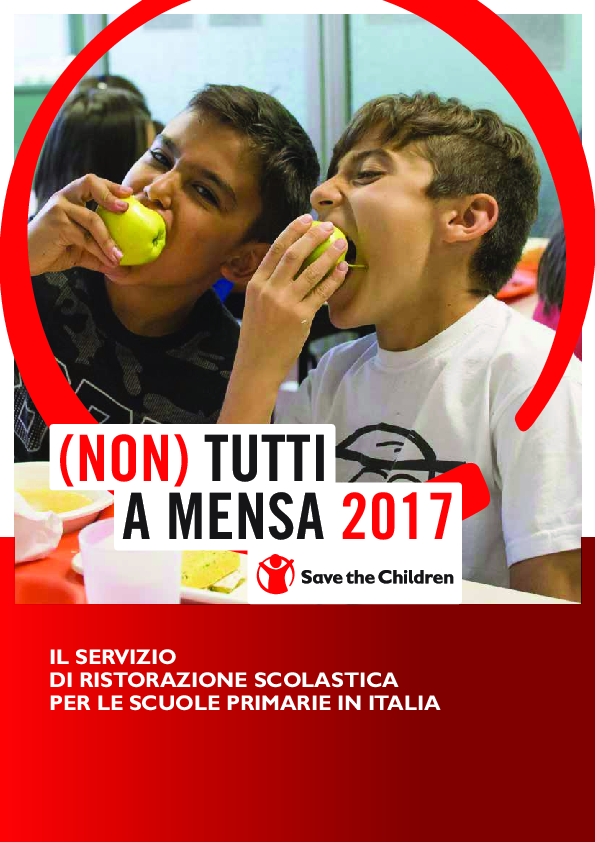
Reports, Study: Research
(Not) All at the School Canteen! 2016
Publication year:
2016
Italian
Format:
pdf (897.6 KiB)
Publisher:
Save the Children Italy
For over three years Save the Children has used the “(Not) All at the School Canteen” slogan to denounce the unequal access to cafeteria service in primary schools and the lack of fairness that still characterizes the cafeterias. The “(Not) All at the School Canteen 2016!” report continued monitoring the 45 municipalities with more than 100,000 inhabitants in order to identify the strong differences related to the access to the service amongst the major towns in Italy. The study compares different variables: fees, more or less restrictive criteria exemptions and reductions, the exclusionary practices applied toward children unable to pay for the service.
Executive Summary in English:
How many children have the opportunity to use the school canteen? The wide lack of a canteen service throughout Italy, denounced in last year report, is confirmed again this year. The situation that emerges from the monitoring activity shows a possible relation between leaving school early, full time attendance at school, and school catering service. According to the latest figures released by the MIUR (Ministry of Education and Research) on the number of children who do not use the canteen service in Italy, a high percentages of students were not provided the service in Sicily (80%), Apulia (73%), Molise (70%), Campania (65%) and Calabria (63%). The lack of access to a canteen service, higher than 50% of pupils in 8 Italian regions, is really alarming: 1 out of 2 children in these regions have no possibility to use the canteen and, therefore, to take advantage of the opportunities it implies, not only on a nutritional level, but also in educational terms.
In Italy, an average of 68% of the classes are not full time, and the percentages rises above 80% in the southern regions such as Sicily and Molise (92%), Campania (89%), and Apulia (84%). Campania, Calabria, Apulia and Sicily record, therefore, amongst the highest percentages of pupils who do not access the canteen service or full-time classes and they are the same regions early school discontinuation reaches the highest peaks.
What’s the burden in percentage points of the cost of the canteen service sustained by the families? To answer this question, the municipalities were asked to state such a percentage, and again, this figure can vary widely: it ranges between the maximum fee applied by municipalities like Bergamo, Forlì, Parma and Brescia that report they charge the families with about 100% of the cost, and the minimum fee applied by municipalities like Syracuse (20%), Reggio Calabria (31%), and Andria (32%). The presence of the school cafeteria and the different prices, discounts and percentage of expense charged on the families are due to the fact that the school lunch service is considered, according to the law, as a public service provided on individual request. In other words: this service is implemented directly by the public bodies in response to the user’s request and it is not an institutional obligation. And still, this service is fundamental for children, whose expense is, in most cases, left for the families and the mothers to sustain. This worsen the difficult situation of these women and, as a consequence, exacerbates their social, professional and economic disadvantage.
Studying the monitoring results more carefully, it becomes apparent that there is a strong discrepancy amongst the single municipal policies, starting from the prices. Catania applies a maximum fee of €2.30 while the maximum fee applied in Ferrara is of €7.28, the minimum fee in Palermo is of €0.3, but the minimum fee in Venice is much higher, €4.25. To actually understand what could be the difference between a child who attends the school canteen in Palermo and another in Genoa, we updated the fee simulation considering two kinds of families: the fees of the families whose ISEE (Equivalent Economic Status Indicator) is less than €5000 and with three children attending the school canteen can vary widely, and, in some cases like in Bergamo and Modena, they exceed €4; the families whose ISEE is €25000 and have one child attending the school canteen can pay a €2.3 fee in Catania and a €6.71 fee in Livorno. There are also 17 municipalities that charge the families with a €5 fees. Poorer families’ difficulty in accessing the service has very often worsen due to the absence of reductions: 11 municipalities out of 45 do not provide an exemption guaranteed for everyone, according to their income, to family composition or social reasons. 8 out of these 11 municipalities provide the possibility of exemption only in cases of social difficulty when it is verified through the notification by the social services, while the 3 municipalities of Bolzano, Padua and Salerno do not provide for any kind of exception. Fee reductions are provided for by all municipalities, but the criteria applied are not homogeneous: each of the 40 municipalities out of 45 that apply reductions in case of economic difficulty establishes its own ISEE threshold: 35 municipalities apply different fees depending on the family composition; 13 municipalities apply reductions also according to the social problems of a family or the notification by social services; while 4 municipalities reduce the fees for families with disable members. The interventions of the municipalities in regulating the access to the canteen, besides being uneven, are likely to be even more restrictive, as in the case of those 26 municipalities out of 45 that don’t give non-residents’ children the opportunity to take advantage of the reductions.
Finally, amongst the 26 municipalities who reported the percentage of missed payments by the families for the canteen service, only 8 have a missed payment percentage greater than or equal to 20%. It seems like there is no positive correlation between policies of exclusion and the low rate of delay in payment: the exclusion of children doesn’t seem to push families to pay their debt (which they fail to pay because of economic reasons). Those municipalities that exclude children whose parents are in default towards the canteen service such as Ancona, Brescia, Foggia, Novara, Palermo, Reggio Calabria, Sassari, Taranto and Salerno are, therefore, examples of bad practices. Despite applying amongst the lowest minimum rates, Salerno did not establish any form of exemption for tuition payments and neither did the municipalities of Bolzano and Padua which, however, provide other forms of support for poorer families. The municipality of Bergamo is one of those municipalities that do not provide for reductions according to ISEE categories, that apply exemption only to residents and only upon notification by social services, despite having one of the highest minimum fee, exceeding €4 for large families with an ISEE which is less than €5000. Moreover, the municipality of Bergamo, along with those of Brescia, Parma and Forlì expect the families to contribute with more than 90% of the cost for the canteen service. There are some municipalities which apply a more inclusive approach and provide for exemptions and reductions in favor of children belonging to needy families, for example the municipalities of Genoa, Novara and Florence. These municipalities apply exemptions or reductions for families whose members have lost their jobs as well as for the families with more than one child enrolled in the service.
In conclusion, this report urges the competent institutions to guarantee free access to the school canteen to all children in need, since article 117, paragraph 2, letter m of the Constitution establishes it is an essential social benefit for children. To achieve this, it is necessary to invest in an equal access to the school canteen throughout Italy, and to ensure the availability of resources allocated to it, such as the Fund for European Aid to the Most Deprived (FEAD), in order to fight, in a coordinated manner, both nutritional and educational poverty of children and teenagers. The municipalities are strongly advised to adopt the same fees throughout the country for all families (residents and non-residents) according to the principle of progressive contributions based on the economic situation of the family itself (ISEE). They are also advised to change the contribution range in favor of users even during the school year, after they provide the current ISEE, without ever excluding from the service the children of defaulting parents.
Read full abstract
Authors
View & Download
Italian
1 Documents
Document information
Publisher
Authors
Format
Content type
Country
Region
Rights
© Author/Publisher
Keywords
Found a mistake? Help us improve!
If you have noticed a document assigned to the wrong author or any other inaccuracies, let us know! Your feedback helps us keep our data accurate and useful for everyone.
Related Documents
Share
Link

